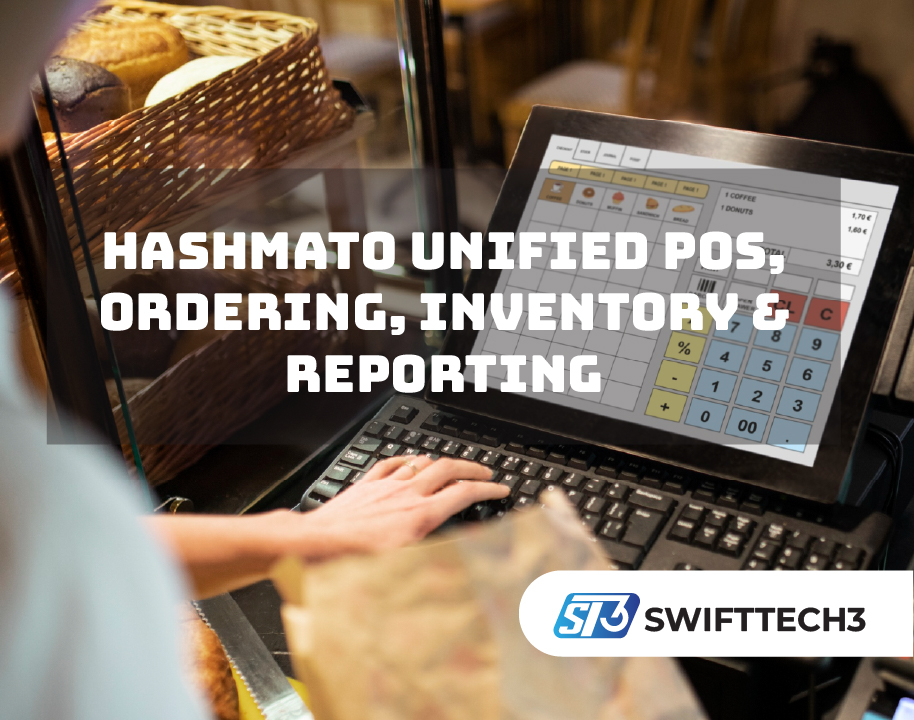Hashmato brings together point of sale, ordering, inventory, and reporting into a single system that helps you run food and retail operations with less friction. Many operators struggles with disconnected systems that causes order errors, stock mismatches, and slow service.
Hashmato addresses those problems by offering a unified POS, online and kiosk ordering, waiter ordering, kitchen display, cloud inventory, and reporting tools on one platform. This reduces manual work and give you more clear, faster access to the numbers you needs to manage staff, suppliers, and customer experience.
Discover how this approach can enhance the efficiency and consistancy of your restaurant, retail outlet, hospital food service, or institutional cafeteria. Hashmato integrates front-of-house and back-of-house workflows so you can focus on service and growth.
In this blog, we’ll explain what a unified POS and ordering stack looks like, shows how it changes daily operations, list concrete benefits you can expect, and outline practical steps to evaluate and adopt a system for single-location outlets up to enterprise franchises.
What A Unified Platform Means For You
A unified platform eliminates the need to integrate multiple apps. Instead of separate systems for ordering, payments, inventory, and kitchen management, you gets a single platform where each module shares the same data in real time. This lower errors and reduces reconciliation work after shifts.
Hashmato provides modules such as POS terminals, waiter ordering app, kitchen display system (KDS), self-ordering kiosks, and online ordering, all designed to work together. When an order is placed on any channel, it flow through the same order lifecycle and updates inventory and sales reports automatically.
How This Changes Daily Operations
You will notice change across operations in four main ways:
- Faster order flow: Orders from dine-in tablets, kiosks, or online are routed instantly to the kitchen display and printed KOTs where needed.
- Fewer reconciliation steps: Sales and payments are recorded in one ledger so end-of-day closing takes less time than before.
- Real-time inventory: Stock levels update automatically as items sell, helping you cut waste and avoid out-of-stock situation.
- Consistent guest experience: Menu changes, pricing, and promotions reflects across every ordering channel immediatly.
Core Components You Should Look For
When evaluating any unified solution, these are the concrete modules that matters most:
- Point of Sale (Tablet or Android POS): for checkout and payment processing.
- Online Ordering System: branded ordering on web and mobile.
- Self-Ordering Kiosk: in-store touchscreens for customer self-service.
- Waiter Ordering App: tableside ordering and instant fire to the kitchen.
- Kitchen Display System (KDS): live queue and order tracking for cooks.
- Cloud Inventory Management: two-way sync for stock taking and purchase management.
- Live Sales App and Cloud Console: remote dashboards and terminal control for managers.
Practical Benefits For Different Business Types
You are likely to see a measurable impact depending on your business model:
- Single-outlet restaurants: Lower staff overhead at peak times with kiosks and faster table turns with waiter tablets.
- Multi-location franchises: Centralized menu control and consolidated reporting lets you compare outlets and roll out updates across locations quicker.
- Hospitals and healthcare food services: Patient meal tracking and dietary customization integrated with inventory and billing.
- Supermarkets and retail boutiques: Unified billing, stock updates, and offline mode to keep tills running during connectivity drop.
- Institutional catering (schools, universities): Batch meal planning, tray management, and multi-campus reporting.
Features That Drive ROI
Here are specific features that contributes to faster returns:
- Offline Mode with Two-Way Sync: Keep selling during internet outages; sync happens automatically when back online.
- 50+ Reports: Standard and downloadable analytics for sales, item performance, and staff productivity.
- 100+ Online Integrations: Plug-ins for popular delivery and third-party platforms to expand reach.
- B2B Operations App: Simplified invoicing and order handling for wholesale or corporate accounts.
- Cloud Console: Remote access to live sales and terminal management.
Real-World Workflow Example
Picture a busy lunch hour at a multi-outlet cafe chain:
- A customer places an order via the branded online ordering page.
- The order hits the unified POS and KDS instantly.
- Inventory reduces in real time; the item shows as low stock if thresholds is crossed.
- Kitchen completes the order, and status updates are visible on the waiter’s app.
- Sales data appears in the cloud console, where you can export daily reports easily.
This unified flow reduces miscommunications and shorten service time.
Implementation Checklist For Smooth Adoption
If you plan to evaluate or switch, follow a clear checklist:
- Map your current channels: dine-in, delivery, takeaway, kiosks, and B2B.
- Identify must-have integrations (payment providers, delivery partners).
- Test offline mode and two-way sync in low-risk hours.
- Run parallel reports for a week to validate sales and inventory accuracy.
- Train a pilot team on the waiter app and KDS before full rollout.
What To Expect From Support And Compliance
Look for vendor commitments on security and compliance, and check for available local support. Hashmato highlights data security as a priority, and a suite of learning resources, such as tutorials and customer stories, to help your staff adapt. The company also notes eligibility for specific government productivity grants where applicable, which can lower adoption costs for small and medium operations.
Common Concerns And How To Handle Them
You might worry about integration effort and downtime. Address those by:
- Running a staged rollout using one outlet as the pilot.
- Keeping legacy systems read-only during the pilot so data can be compared easily.
- Scheduling cutover during low business hours.
- Using vendor-provided onboarding materials and demos to shorten staff training.
Measuring Success
Use clear KPIs to judge effectiveness:
- Average order-to-delivery time.
- Daily sales reconciliation time reduction.
- Inventory variance rate month-on-month.
- Order error rate per 1,000 orders.
- Customer repeat rate and online conversion for direct ordering.
Track these metrics before and after implementation to quantify benefit.
Final Thoughts
Unified systems reduce manual work and help you run consistent operations, whether you manage a single outlet or a national chain. When the front-of-house, kitchen, inventory, and reporting communicate with the same data set, you spend less time fixing problems and more time on product and service. If you wants to explore how this architecture applies to your specific setup, start with a pilot at one location, use concrete KPIs, and scale when the results meet your targets.
If you want to know more about the exact modules, integrations, and customer stories behind the platform mentioned at the start of this post, visit the company site linked earlier to review product pages, case studies, and technical details.

FAQ’s
A unified POS system combines ordering, payment, inventory, and reporting into one platform. You dont need multiple apps, which reduces mistakes, saves time, and improves customer experience. It’s useful for restaurants, retail stores, and institutional catering.
Yes! Hashmato supports multi-location setups and has offline mode with two-way sync. This means even if internet goes down, sales and inventory are updated automatically when connection returns.


